- 16 Jan 2025
- 29 Minutos para leer
-
OscuroLigero
Metodologías de Puntuación de Investigación
- Actualizado en 16 Jan 2025
- 29 Minutos para leer
-
OscuroLigero
G2 se esfuerza por ser el mercado más confiable e influyente del mundo para compradores, vendedores y proveedores de servicios de software. Además del riguroso proceso de moderación de reseñas de G2, esa confianza se gana aplicando un conjunto consistente de pautas, metodologías y definiciones para dar a los compradores la mejor visión de un mercado de software B2B en particular.
Sin embargo, tenga en cuenta que todas las reseñas se basan en experiencias subjetivas de los usuarios, que pueden ser incompletas y estar sujetas a circunstancias únicas. Las reseñas no constituyen opiniones de expertos basadas en criterios objetivos. Más bien, las reseñas son subjetivas, basadas en las experiencias de los usuarios, y pueden depender en parte de sus calificaciones profesionales, que G2 no ha revisado ni confirmado.
Esta página contiene información detallada sobre las metodologías de puntuación de investigación de G2, incluyendo puntuación para productos de software y proveedores de servicios, lógica de clasificación y criterios de inclusión del informe de mercado de G2. Revisamos continuamente y luchamos por mejorar nuestras metodologías. Esta página es solo para fines informativos generales.
Puntuación G2
G2 utiliza un algoritmo propietario para clasificar productos según las reseñas recopiladas de la comunidad de usuarios, así como datos agregados de fuentes en línea y redes sociales. El resultado de este algoritmo es la Puntuación G2, que es una puntuación estandarizada utilizada para comparar productos dentro de la misma categoría de G2.
Las puntuaciones para un producto o servicio pueden diferir entre sus correspondientes categorías de G2 debido a las reseñas analizadas y al proceso de normalización de puntuaciones de G2.
Esta sección describe las metodologías de puntuación discretas utilizadas para calcular la Puntuación G2 para software y proveedores de servicios.
Software
La Puntuación G2 de un software se calcula utilizando dos componentes de puntuación: Satisfacción y Presencia en el Mercado.
Satisfacción
La puntuación de Satisfacción de G2 se deriva de las siguientes métricas.
| Grupo de métricas | Métrica | Descripción | Importancia |
|---|---|---|---|
| Datos de respuesta de reseñas | Puntuaciones centradas en el usuario | Preguntas del formulario de reseña de G2:
|
High |
| Admin-focused scores | G2 review form questions:
|
Medium | |
| General satisfaction scores | G2 review form questions:
|
Low | |
| Significance | Review volume | To assess popularity and statistical significance, review response data is weighted based on the total number of reviews. | High |
| Relevance | Review recency | Because recent reviews are more relevant to buyers, older reviews are weighted less. For more information, refer to the {-=a=-} section. | High |
| Review quality | Reviews that are more thoroughly completed are weighted more heavily. Each review is assigned a readability score using the {-=a=-} scale. | Medium | |
| Review source | Reviews collected from current product users or from users who have more experience with the product are given increased weight. Reviews solicited without incentive are also weighted more heavily. De acuerdo con las directrices de la Comisión Federal de Comercio (FTC), los proveedores no deben segmentar a los clientes para solicitar solo reseñas positivas. Cualquier reseña obtenida a través de segmentación viola las Directrices de la Comunidad de G2 y está sujeta a eliminación. |
Low |
Presencia en el Mercado
La puntuación de Presencia en el Mercado de G2 incorpora métricas derivadas de las reseñas de G2 y de fuentes externas. La Presencia en el Mercado se basa en datos tanto de productos como de sus proveedores correspondientes, dando mayor peso a las métricas específicas de productos.
La siguiente tabla describe varios factores clave que influyen en la puntuación de Presencia en el Mercado de G2, listados en orden de importancia.
| Grupo de Métricas | Métrica | Descripción | Importancia |
|---|---|---|---|
| Número de reseñas | Número de reseñas ponderadas por categoría | El número de reseñas no asociadas a negocios atribuidas a la categoría. Las reseñas se ponderan en función de los mismos factores utilizados en el puntaje de Satisfacción de G2, incluyendo calidad de la reseña, recencia de reseña y fuente de reseña. | Alto |
| Número de empleados y ingresos Consulte el apéndice de puntuación para más información. |
Empleados en ZoomInfo | El número de empleados reportados por ZoomInfo. | Alto |
| Empleados en LinkedIn | El número de empleados reportados por LinkedIn. | Alto | |
| Empleados en Crunchbase | El número de empleados reportados por Crunchbase, representado como un rango. | Medio | |
| Ingresos en ZoomInfo | Los ingresos estimados de software B2B reportados por ZoomInfo. | Medio | |
| Presencia en la web | Autoridad de la página del producto Moz | Qué tan bien se clasificará la página web del producto en las páginas de resultados de motores de búsqueda (SERPs), predecido por Moz. | Medio |
| Volumen de búsqueda estimado | El volumen estimado para términos de búsqueda de marca del proveedor basado en datos de STAT Search Analytics y otras fuentes. | Medio | |
| Tráfico de la página del producto | El tráfico de la página del producto se basa en el tráfico del sitio y la parte del tráfico por página, reportado por Similarweb (solo de escritorio). | Bajo | |
| Autoridad de dominio del proveedor Moz | Qué tan bien se clasificará el sitio web del proveedor en las páginas de resultados de motores de búsqueda (SERPs), predecido por la Autoridad de Página de Dominio de Moz. | Bajo | |
| Visitas totales SimilarWeb | Número estimado de visitas al dominio durante el último mes, reportado por Similarweb. | Bajo | |
| Gastos PPC SimilarWeb | El gasto publicitario estimado para las palabras clave de búsqueda pagada del proveedor durante el último mes, reportado por Similarweb. | Bajo | |
| Nuevos visitantes Similarweb | El número de visitantes únicos que han visitado el sitio web del proveedor en al menos tres meses, reportado por Similarweb (solo de escritorio). | Bajo | |
| Tráfico de búsqueda orgánica Similarweb | El número de visitantes que llegan al sitio web del proveedor a través de resultados de búsqueda no pagados (orgánicos), reportados por Similarweb. | Bajo | |
| Crecimiento, influencia y compromiso | Rango Crunchbase | El rango de Crunchbase para el proveedor. Crunchbase clasifica organizaciones en varias variables, incluyendo el monto total de financiación, la relación con otras organizaciones y las visualizaciones de página. | Bajo |
| Crecimiento de empleados del proveedor | El cambio en el número de empleados desde la última vez que se verificó el tamaño de la empresa en LinkedIn, normalizado por el tamaño de la empresa. El crecimiento de empleados se reporta para un proveedor 12 meses después de su primera aparición en G2 Grid®. |
Bajo | |
| Año de fundación | El año en que se fundó el proveedor. Los proveedores que han estado en el negocio por más tiempo son ponderados más positivamente. | Bajo |
Suites de productos
Las suites de productos son agrupaciones de productos que ofrecen a los compradores una gama ampliada de características y funcionalidades, integraciones preconstruidas y una relación simplificada con el proveedor. Cada Suite de Productos G2 tiene su propio perfil, que puede ser personalizado en my.G2.

Los perfiles de suites agregan las reseñas de cada uno de los perfiles de productos de la suite, y cada reseña incluye el nombre del producto original evaluado.

Los clientes pueden escribir reseñas para una suite de productos, que también aparecen en los perfiles de productos correspondientes.
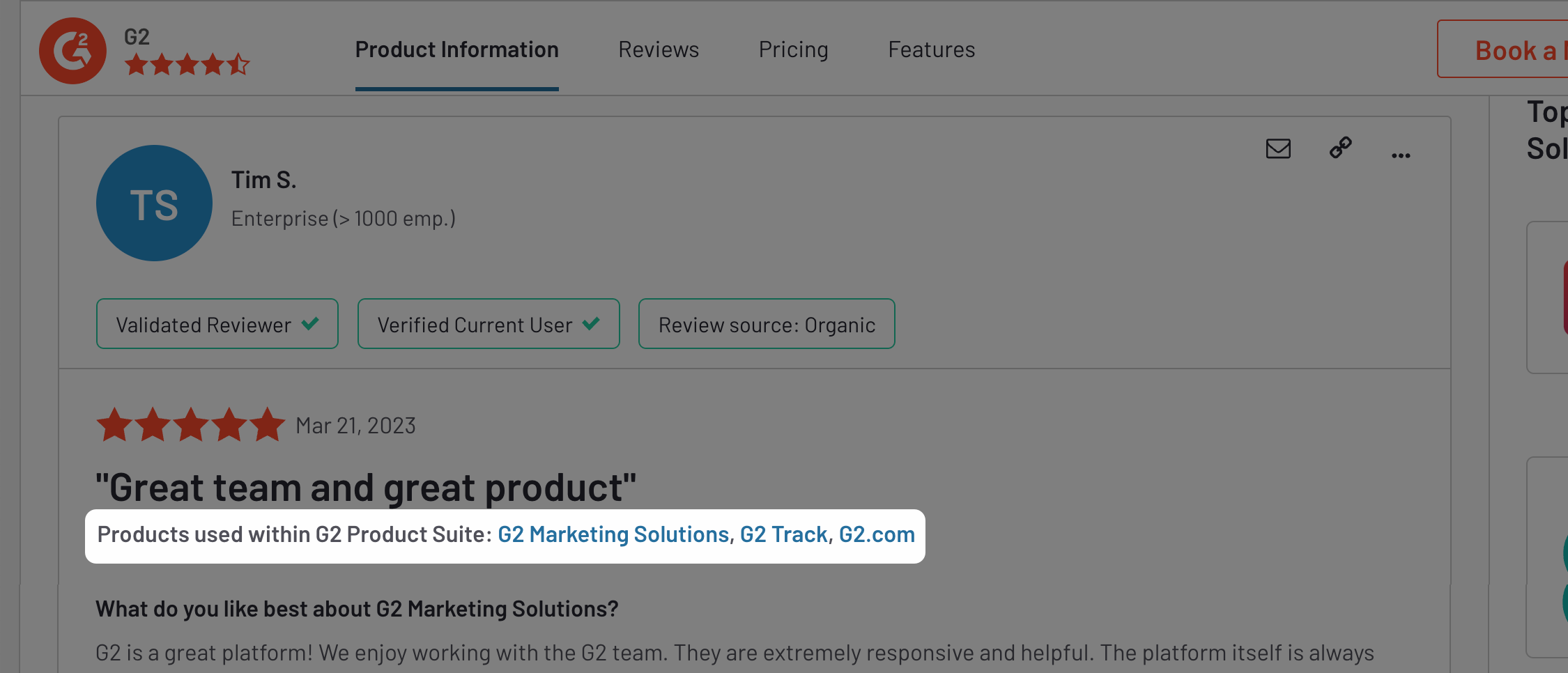
Las reseñas para los perfiles de suites de productos no afectan la puntuación de G2 ni los criterios de inclusión para los Informes de Mercado de G2 para suites de productos o sus productos asociados.
De manera similar a cómo las suites de productos agrupan productos listados en G2, las categorías de suites de productos permiten a los compradores comparar soluciones con funcionalidades que abarcan múltiples categorías de G2.
Para ser incluida en una categoría de suite, una suite debe tener productos listados en G2 en todas las categorías de productos requeridas determinadas por el equipo de Investigación de Mercado de G2.
Dos tipos de categorías de productos pueden incluirse en una categoría de suite:
- Categorías básicas definen las características esenciales de la categoría de suite de productos. Una solución debe ofrecer todas las características requeridas de las categorías básicas según lo definido por el equipo de investigación de G2.
- Categorías suplementarias son comúnmente vistas en soluciones de competidores pero no son necesarias para la funcionalidad básica de la solución. Una suite de productos no está obligada a tener productos en ninguna categoría suplementaria para calificar para inclusión en la categoría de suite.
Las suites de productos utilizan la misma metodología de puntuación de Satisfacción y Presencia en el Mercado que productos de software, pero las puntuaciones se agregan a través de las categorías, con las categorías básicas recibiendo mayor peso que las categorías suplementarias.
Puedes verificar los requisitos para una categoría de suite navegando a la página de categoría correspondiente en G2 y luego consultando las categorías básicas enumeradas. Por ejemplo, para ser elegible para una categoría de suite Plataformas de Ventas, tu suite debe tener uno o más productos en las categorías de productos CRM y Análisis de Ventas.

Servicios
La puntuación G2 de un proveedor de servicios se calcula utilizando dos componentes de puntuación: Satisfacción y Presencia/Proficiencia en el Mercado.
Satisfacción
El puntaje de Satisfacción de G2 para proveedores de servicios se deriva de las siguientes métricas.
| Métrica | Descripción | Importancia |
|---|---|---|
| Datos de respuesta de revisión | El formulario de revisión de proveedores de servicios de G2 contiene un conjunto distinto de atributos centrados en el servicio que evalúan la relación proveedor-cliente, incluidos Profesionalismo, Expertise del Equipo, Capacidad de Respuesta, Capacidad de Ejecución y Habilidades de Comunicación. | Alto |
| Volumen de revisión | Para evaluar la popularidad y la significación estadística, los datos de respuesta de revisión se ponderan según el número total de revisiones. | Alto |
| Recencia de revisión | Debido a que las revisiones recientes son más relevantes para los compradores, las revisiones más antiguas tienen menos peso. Para más información, consulta la sección Decaimiento de Reseñas. | Medio |
| Calidad de revisión | Las revisiones que están más completas se ponderan más. Cada revisión recibe un puntaje de legibilidad usando la escala Flesch-Kincaid Reading Ease. | Bajo |
Presencia/Proficiencia en el Mercado
El puntaje de Presencia/Proficiencia en el Mercado de G2 para proveedores de servicios incorpora métricas que evalúan la competencia, experiencia y alcance de un proveedor de servicios.
| Grupo de métricas | Métrica | Descripción | Importancia |
|---|---|---|---|
| Capacidades y Competencias | Expertise en la categoría | El número de competencias de software distintas asociadas a un proveedor de servicios de ecosistema, como lo verifica el equipo de Investigación de Mercado de G2. Esta métrica solo se utiliza para proveedores dentro de las subcategorías de la Categoría madre de Prestadores de Servicios de Ecosistema. |
Alto |
| Edad de la Empresa | Año de Fundación | El año en que se fundó la empresa. Los proveedores de servicios que han estado en el negocio más tiempo se ponderan más positivamente. | Medio |
| Diversidad Geográfica | Países de los Revisores | El número de países únicos representados entre los revisores de un proveedor. | Medio |
| Países de Operación | El número de países donde un proveedor realiza negocios, según lo reportado por ZoomInfo. | Medio | |
| Idiomas | El número de idiomas soportados por un proveedor de servicios, según lo reportado por el proveedor. | Bajo |
Accediendo a tus datos de puntuación
Puedes acceder a las puntuaciones de Satisfacción y Presencia en el Mercado para tu producto a través de la pestaña Competidores en my.G2.
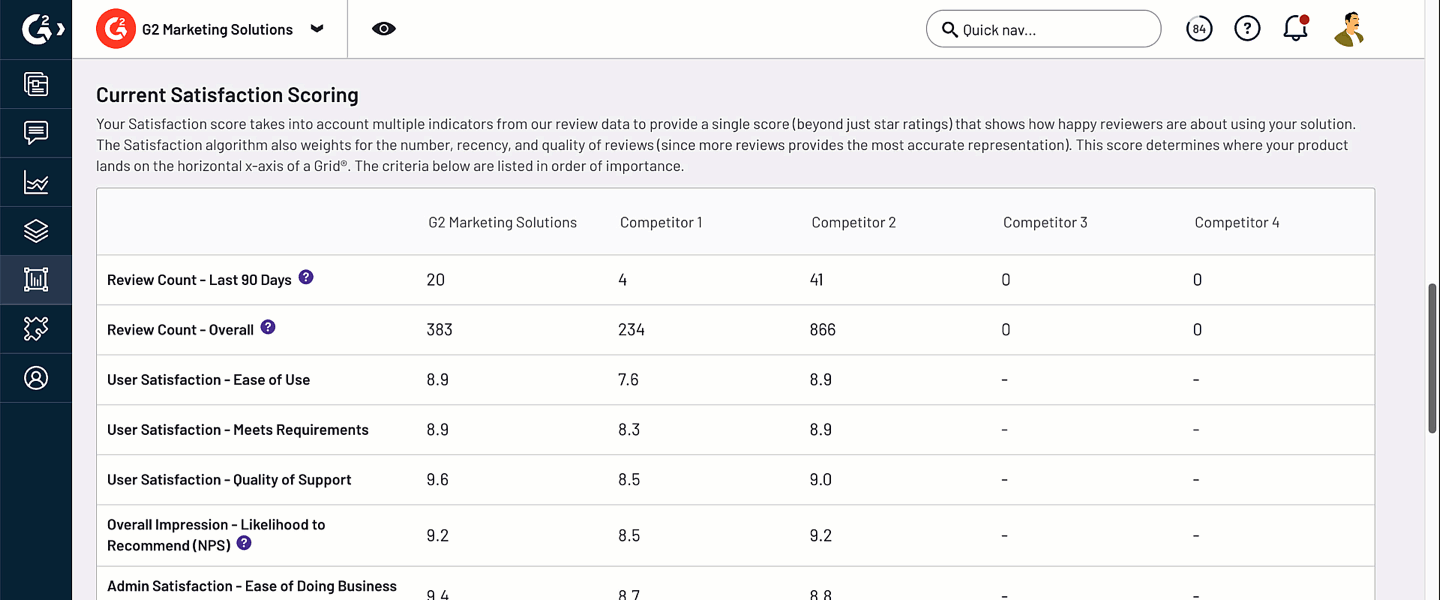
my.G2 muestra las entradas crudas de las puntuaciones de Satisfacción y Presencia en el Mercado de G2, que se actualizan en función de las frecuencias enumeradas en la sección Frecuencia de actualización de métricas. Para obtener más información sobre cómo se utilizan estos datos para calcular la puntuación G2 de tu producto, consulta las secciones Normalización y Número de empleados e ingresos.
Para más preguntas relacionadas con datos de fuentes externas, comuníquese primero con G2 Support. Es posible que necesites ponerte en contacto con las fuentes de terceros directamente para solicitar actualizaciones.
También puedes visualizar la distribución de las revisiones de tu producto en relación con el algoritmo de decaimiento de revisiones de G2 desde la pestaña Actividad de Revisiones.
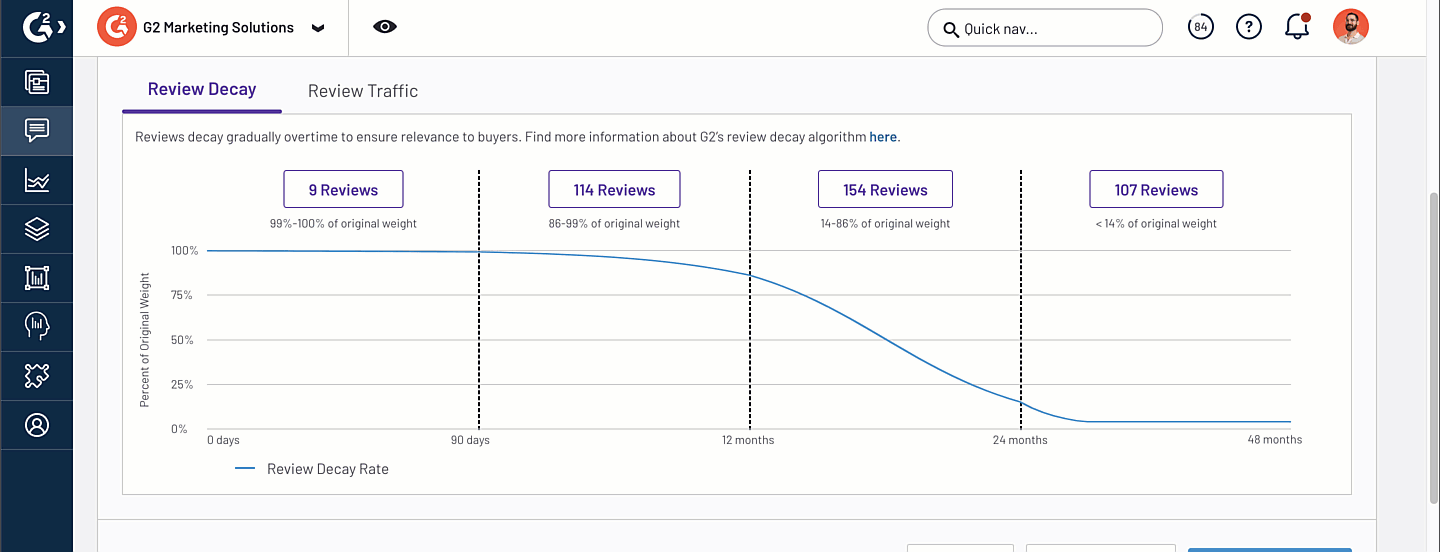
Consulta la sección Decaimiento de Revisiones para más información.
Apéndice de Puntuación
Esta sección proporciona información suplementaria sobre las puntuaciones de Satisfacción y Presencia en el Mercado de G2.
Normalización
Para asegurar que los compradores entiendan cómo se desempeña tu producto en relación con tu paisaje competitivo, G2 pondera y normaliza la puntuación para todos los productos de tu categoría en una escala de 0 a 100.
Esto significa que el rango de tu producto se determina tanto por las puntuaciones brutas como por la distribución de puntuaciones entre los competidores de tu categoría.
Por ejemplo, si varios productos están cerca de la media de la categoría, pequeñas diferencias en las puntuaciones absolutas pueden recibir una magnitud adicional durante el proceso de normalización para asegurar que los compradores puedan identificar fácilmente las diferencias entre los productos.
Decaimiento de Revisiones
Para que la puntuación de Satisfacción y Presencia en el Mercado mantenga relevancia para los compradores en cualquier momento, G2 aplica un decaimiento a las revisiones a medida que envejecen. El decaimiento comienza en el momento en que se envía una revisión y se recalcula diariamente.
Específicamente, una revisión se degrada gradualmente durante los primeros 90 días y mantiene un mayor peso durante los primeros 18 meses, después de lo cual la tasa de decaimiento se acelera. Después de aproximadamente tres años, la revisión alcanza aproximadamente el 3% de su peso original y mantiene ese peso de forma indefinida.
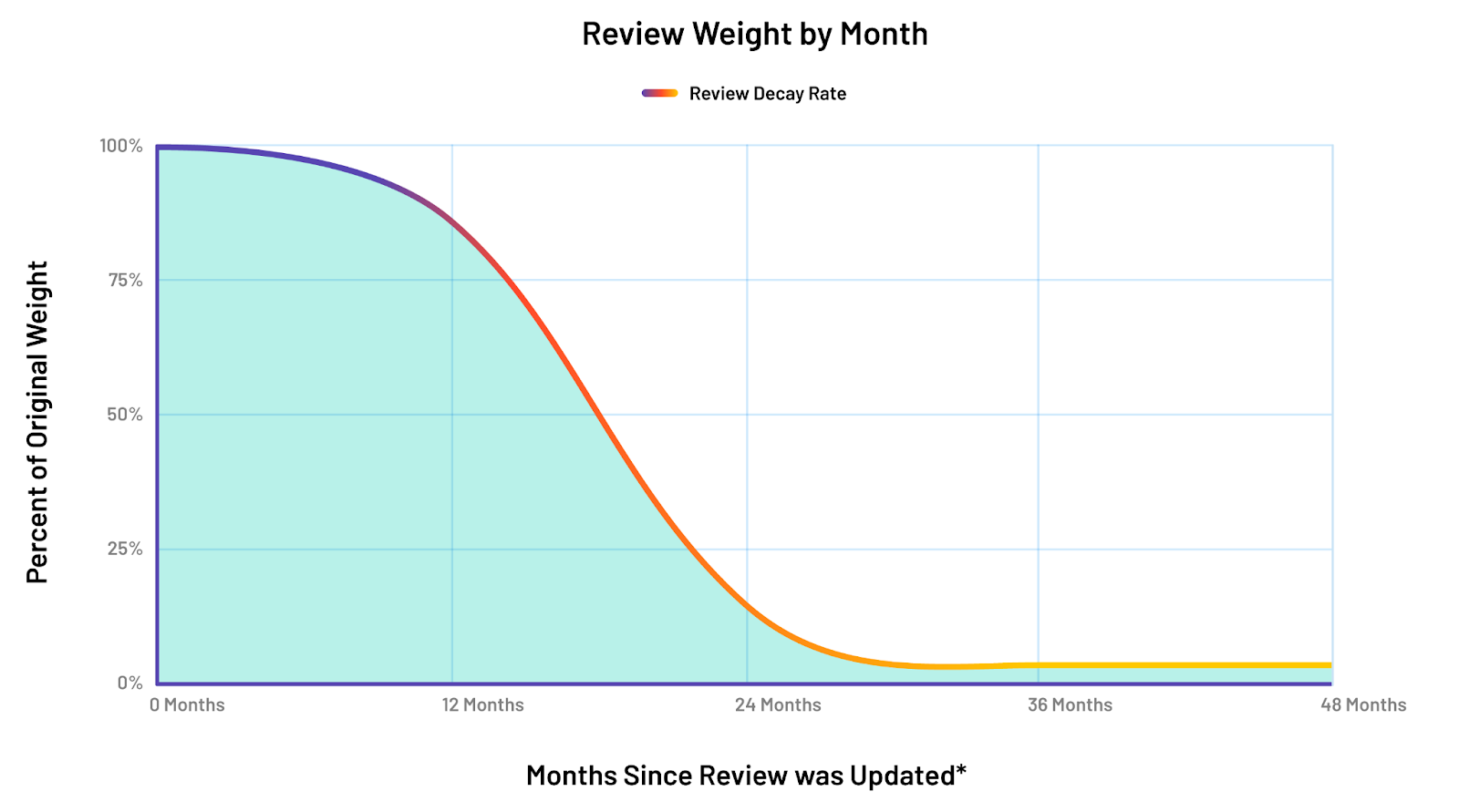
El decaimiento de las revisiones se reinicia si un revisor actualiza su revisión existente.
Socios comerciales
Los usuarios que tienen una relación comercial con un proveedor, como revendedores, a menudo pueden proporcionar información valiosa y no tienen restricciones para dejar revisiones en G2. Sin embargo, debido al sesgo potencial de tales relaciones, las revisiones de socios comerciales no impactan la calificación con estrellas, el G2 Score, las puntuaciones de Satisfacción o de Presencia en el Mercado, las listas de Mejor Software o otros algoritmos de clasificación de G2. Estas revisiones están marcadas con una etiqueta "Socio Comercial" en la revisión.
Usuarios invitados
Los usuarios que han sido invitados a usar un software fuera de su organización o usar el software para un propósito ocasional no tienen restricciones para dejar revisiones en G2. Las revisiones de usuarios invitados no impactan la calificación con estrellas, el G2 Score, las puntuaciones de Satisfacción o de Presencia en el Mercado, las listas de Mejor Software o otros algoritmos de clasificación de G2. Estas revisiones están marcadas con una etiqueta "Usuario Invitado" en la revisión.
Presencia en la Web
Esta sección proporciona más información sobre las fuentes de terceros que G2 utiliza para evaluar la presencia en la web:
- Moz Product Page Authority predice cómo se clasificará una página específica en las páginas de resultados de los motores de búsqueda (SERP). G2 utiliza la autoridad de páginas que destacan las características y funcionalidad de un producto para evaluar la presencia en la web en comparación tanto con el paisaje competitivo como con otros productos que un proveedor puede ofrecer.
- Moz Domain Authority predice cómo se clasificará un dominio en SERP y rastrea la fuerza general del sitio web de un proveedor en los rankings de SEO orgánico.
- Similarweb Total Visits mide el número estimado de visitas a un dominio durante el último mes. G2 utiliza el tráfico total como una escala relativa (bajo, medio, alto) para evaluar la fortaleza de un proveedor en tráfico.
- Similarweb PPC Spend rastrea el gasto estimado de un dominio en términos de búsqueda PPC en desktop y móvil durante el último mes (USD). G2 utiliza el presupuesto de tráfico como una escala relativa (bajo, medio, alto) para tener en cuenta el crecimiento de la presencia en la web no orgánica.
- STAT Search Analytics rastrea los términos de búsqueda de la marca de la compañía para medir el interés general en un producto o empresa y proporcionar una medida prospectiva de cuántos usuarios o clientes puede tener un producto. G2 realiza ajustes en los números brutos de volumen de búsqueda para tener en cuenta las búsquedas que pueden no estar relacionadas con el producto de software. Esta información se combina con otras señales web para estimar el nivel de interés en un producto específico.
Contador de empleados e ingresos
El número de empleados se utiliza tradicionalmente como un proxy para evaluar el tamaño de la empresa, los recursos disponibles, y un predictor para los ingresos, ya que más empleados permiten mayor productividad y producción en general.
G2 considera que esta información es importante para transmitir a los compradores para ayudarles a evaluar el éxito del producto de software, las expectativas sobre implementación y soporte, y cuán establecida está una empresa. G2 utiliza múltiples fuentes de terceros, incluyendo ZoomInfo, LinkedIn y Crunchbase, para mitigar inexactitudes en la contabilidad de empleados y datos de ingresos.
Las empresas que tienen operaciones significativas generadoras de ingresos fuera del software B2B solo reciben el número de empleados estimado que se cree que se enfocan en actividades que generan ingresos relacionadas con el software B2B.
Por ejemplo, si la Compañía de Entrega X tiene una aplicación orientada a B2B para que las empresas gestionen y monitoreen sus entregas de paquetes, pero sus estados financieros públicos indican que su software de gestión de entregas solo representa el 3% de sus ingresos, un máximo del 3% de su total de empleados se usará en los cálculos de Presencia en el Mercado.
Además, para grandes empresas, G2 mapea el total de empleados y los ingresos de la organización a productos y categorías individuales basándose en la información disponible, incluyendo una combinación de conteos de reseñas ponderadas y datos de fuentes de terceros, como el ranking SERP para productos individuales.
Frecuencia de actualización de métricas
G2 actualiza datos de primera y tercera parte en la siguiente cadencia.
| Fuente | Frecuencia de actualización |
|---|---|
| Crunchbase | Diariamente |
| Participación del empleado | Diariamente |
| Contador y calificaciones de G2 | Diariamente |
| Similarweb | Mensual |
| STAT Search Analytics | Semanal |
| Mensual | |
| Moz | Mensual |
| ZoomInfo | Mensual |
Fusiones y adquisiciones
When a product is acquired, G2 tracks metrics for both the acquiring and acquired organization to support Market Presence calculations.
El impacto de una adquisición dependerá tanto de la fecha de la adquisición como del tipo de adquisición. Los cambios en las métricas web y sociales, si los hubiere, se producirán tan pronto como los cambios de la taxonomía se reflejen en G2.com. Los cambios en las estimaciones de empleados y revenue de G2 se implementan en un período de 18 meses a partir del cierre de la adquisición.
Para solicitar actualizaciones en las métricas de su empresa después de la adquisición, consulte las directrices de envío, luego contacte a Soporte G2.
G2 usa la siguiente lógica para manejar las actualizaciones de Presencia de Mercado para fusiones y adquisiciones:
| Tipo de adquisición | Descripción |
|---|---|
| Adquisición financiera | Las adquisiciones puramente financieras, como la adquisición por una firma de capital privado, no tienen impacto directo en la Presencia de Mercado porque no hay cambio en el número de empleados del proveedor, la presencia en línea u otros detalles firmográficos. |
| Adquisición de subsidiaria | Las operaciones comerciales, el sitio web y la marca permanecen independientes. G2 continúa haciendo seguimiento de los empleados y los ingresos de la organización adquirida, pero hace un ajuste al alza a estas métricas para reflejar los recursos adicionales de la empresa matriz. El tamaño del ajuste depende del tamaño relativo de las dos organizaciones, pero tiende a tener un impacto modesto en la Presencia de Mercado. Las métricas web, las métricas sociales, el año de fundación, el crecimiento de empleados del proveedor y las calificaciones de Glassdoor continúan reflejando la organización adquirida. Este ajuste no es visible en my.G2. |
| Adquisición divisional | Las operaciones comerciales se combinan, pero la organización adquirida mantiene su propio sitio web y su propia marca. Esto generalmente resulta en perfiles separados de LinkedIn, Crunchbase y ZoomInfo para las organizaciones. G2 continúa haciendo seguimiento de los empleados y los ingresos de la organización adquirida, pero hace un ajuste al alza a estas métricas para reflejar los recursos adicionales de la empresa matriz. El tamaño del ajuste depende del tamaño relativo de las dos organizaciones. Las métricas web, las métricas sociales, el año de fundación, el crecimiento de empleados del proveedor y las calificaciones de Glassdoor continúan reflejando la organización adquirida. Aunque el impacto es mayor que el de una adquisición de subsidiaria, el cambio general en la Presencia de Mercado puede ser modesto, ya que las métricas de Presencia de Mercado específicas del producto reciben el mayor peso en la puntuación. Este ajuste no es visible en my.G2. |
| Fusión de empresa | Las operaciones comerciales, los sitios web y la marca de las organizaciones adquirientes y adquiridas se combinan, pero los productos todavía se pueden comprar de forma independiente. Los empleados y los ingresos de la organización adquirida se integran gradualmente para reflejar la nueva cuenta de empleados y los ingresos de la organización adquiriente. Una vez que la integración esté completa, G2 estima la participación de empleados y los ingresos de la misma forma que todos los proveedores de múltiples productos. Las métricas web, las métricas sociales, el año de fundación, el crecimiento de empleados del proveedor y las calificaciones de Glassdoor se actualizan poco después de que se registre la adquisición. |
| Fusión de productos | Las operaciones comerciales, el sitio web y la marca de las organizaciones adquirientes y adquiridas se combinan, y la funcionalidad de cada producto se combina en una sola oferta. Todas las reseñas relevantes, según lo evaluado por el equipo de investigación de G2, se trasladan al nuevo producto combinado. El producto combinado hereda la categorización de los antiguos productos y la participación estimada de empleados y ingresos dedicada a cada categoría. Los empleados y los ingresos de la organización adquirida se integran gradualmente para reflejar la nueva cuenta de empleados y los ingresos de la organización adquiriente. Una vez que la fase de integración esté completa, G2 estima la participación de empleados y los ingresos de la misma forma que todos los productos de múltiples categorías. Las métricas web, las métricas sociales, el año de fundación, el crecimiento de empleados del proveedor y las calificaciones de Glassdoor se actualizan poco después de que se registre la adquisición. |
Clasificación
Esta sección describe la lógica utilizada para clasificar reseñas en los perfiles de productos de G2, productos o servicios en las páginas de categorías de G2 y competidores en las páginas de alternativas de G2.
Reseñas
De forma predeterminada, las reseñas en tu perfil de G2 se muestran utilizando G2 Sort, un algoritmo de ordenación personalizado que incorpora los siguientes puntos de datos:
- Recencia de la reseña
- Cantidad de comentarios proporcionados en la reseña
- Atribución (¿El revisor mantuvo su nombre y empresa públicos?)
- Si el revisor es un usuario actual de la solución (incluyó una captura de pantalla)
- Participación de la comunidad con la reseña

G2 también ofrece las siguientes opciones de clasificación de reseñas a los compradores:
- Más Reciente: Ordenar por fecha.
- Más Útil: Ordenar por mayor participación de la comunidad, incluyendo me gusta y comentarios.
- Más Alto/Más Bajo Calificado: Ordenar por calificación estelar.
La calificación estelar de tu producto se basa en las respuestas a la pregunta Probabilidad de Recomendación en el formulario de reseña de G2.

G2 calcula la calificación estelar promedio de tu producto dividiendo las respuestas a la pregunta Probabilidad de Recomendación por dos, luego redondeando al medio estrella más cercano.
Pros y Contras
Pros y Contras destacan las fortalezas y debilidades de los productos en relación con su categoría.

Todas las reseñas basadas en texto, incluyendo las reseñas de G2 Product Suite, son consideradas para Pros y Contras. Las reseñas en video y las reseñas de socios comerciales no están incluidas en el análisis.
G2 examina todas las reseñas de una categoría de los últimos 18 meses, luego identifica cinco Pros comunes y cinco Contras comunes a través de la categoría. Los Pros y Contras se asignan a un producto basado en la similitud semántica con al menos una de sus reseñas.
Los Pros y Contras se actualizan cada 30 días el 17 del mes y son revisados por G2 para garantizar la calidad.
Si un producto está en múltiples categorías de G2, se mostrarán los cinco principales Pros y Contras, basados en el mayor número de reseñas asociadas, a través de todas las categorías.
Sentimiento General de la Reseña
El Sentimiento General de la Reseña proporciona información de las reseñas de G2 sobre varias medidas de sentimiento del cliente para productos, suites de productos y servicios.

El panel Sentimiento General de la Reseña aparece cuando un producto, suite de productos o servicio tiene al menos 10 respuestas a una de las preguntas del formulario de reseña correspondientes.

Si un producto, suite de productos o servicio no tiene al menos 10 respuestas a cualquiera de las preguntas correspondientes, el panel Sentimiento General de la Reseña no aparecerá en el perfil.
Los datos de sentimiento de las reseñas se actualizan diariamente.
Perfiles de productos y suites de productos

G2 muestra respuestas promedio a las siguientes preguntas del formulario de reseña en el panel Sentimiento General de la Reseña para productos y suites de productos.
| Escala de Sentimiento | Pregunta del formulario de reseña | Opciones de respuesta |
|---|---|---|
| Tiempo de Implementación | ¿Cuánto tiempo tardó en estar operativo? | < 1 día, < 1 mes, 1-3 meses, 3-6 meses, 6-12 meses, > 12 meses, Nunca |
| Facilidad de Configuración | Facilidad de Configuración | Las opciones de respuesta varían de 1 a 7. |
| Retorno sobre Inversión | ¿Cuál es el ROI estimado de su organización sobre {reviewed_product} (período de recuperación en meses)? | 6 meses o menos, 7-12 meses, 13-24 meses, 24-36 meses, 37-48 meses, 48+ meses, Nunca tuvo retorno completo |
G2 promedia y escala las respuestas de reseñas para las preguntas correspondientes del formulario de reseña para generar gráficos del Sentimiento General de las Reseñas.
Servicios

G2 muestra respuestas promedio a las siguientes preguntas del formulario de reseña en el panel Sentimiento General de la Reseña para servicios.
| Escala de Sentimiento | Pregunta del formulario de reseña | Opciones de respuesta |
|---|---|---|
| Comunicación | Habilidades de Comunicación | Las opciones de respuesta varían de 1 a 7. |
| Reactividad | Reactividad | Las opciones de respuesta varían de 1 a 7. |
| Capacidad de Ejecución | Capacidad de Ejecución | Las opciones de respuesta varían de 1 a 7. |
Las respuestas a preguntas con un rango de opciones de respuesta de 1-7 se convierten a un porcentaje y se escalan de 0 a 10.
Categoría
Por defecto, las páginas de categorías de G2 están ordenadas por el G2 Score de tu producto o servicio. Para más información sobre cómo se calcula el G2 Score, consulta la sección G2 Score.
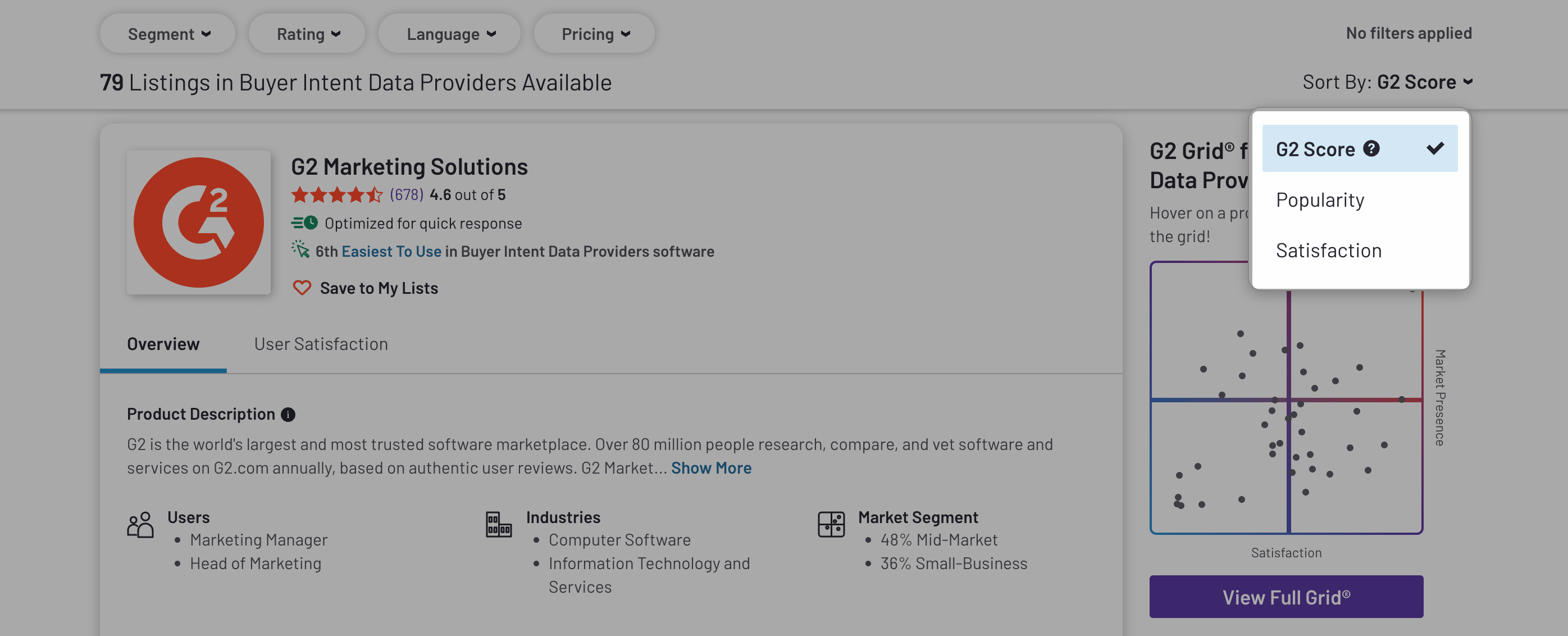
G2 también ofrece las siguientes opciones de clasificación de categorías a los compradores:
- Popularidad: Clasificar por el número total de reseñas.
- Satisfacción: Clasificar por el puntaje de Satisfacción.
Para ser elegible para G2 Sort, una categoría debe tener al menos tres productos con más de 10 reseñas. De lo contrario, los productos se ordenarán por popularidad por defecto.
Alternativas
Las páginas de alternativas de G2 permiten a los compradores encontrar soluciones más similares en funcionalidad al producto o servicio destacado.
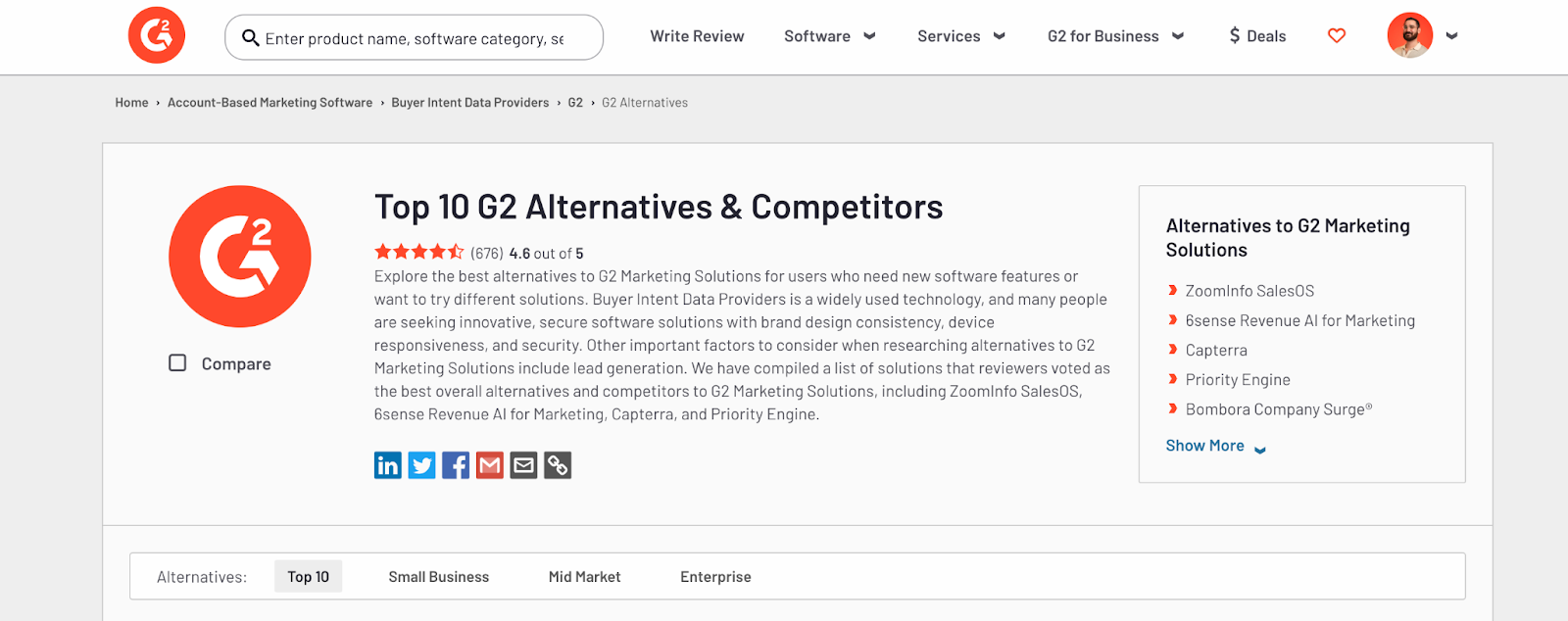
G2 utiliza la siguiente lógica para clasificar las alternativas:
- El número de categorías compartidas entre la solución presentada y el competidor (amplitud de similitud).
- El número de reseñas atribuidas a cada categoría de superposición (profundidad de similitud).
- El número de comparaciones con el competidor realizadas por los usuarios de G2 (similitud de compradores de G2).
Comparaciones
Las páginas de perfil de G2 enumeran las cinco comparaciones principales realizadas por los usuarios para cada producto.

Informes
G2 publica informes de mercado estacionales para ayudar a los compradores a aprender sobre las tendencias en software y servicios, comparar calificaciones de reseñas y encontrar la solución adecuada para sus necesidades.
Consulta la Agenda de Investigación de G2 para acceder a las fechas clave de los próximos informes de G2, incluidos los plazos de presentación de reseñas y las fechas de publicación de informes.
Los informes de mercado estacionales se publican a nivel de categoría. G2 solo ofrece un informe cuando toda la categoría cumple con un umbral específico de reseñas. Para obtener más información sobre los requisitos para que una categoría sea elegible para cada informe, navega a la sección correspondiente de esta documentación utilizando los enlaces a continuación.
G2 actualmente ofrece informes de Grid estacionales por categoría elegible (incluidas grillas de segmentos, grillas regionales y grillas de momentum), así como un conjunto de informes de índice (incluidos el índice de usabilidad, el índice de resultados, el índice de implementación y el índice de relación).
G2 también publica un informe anual sobre el Mejor Software para celebrar el software sobresaliente en G2.
Informes Grid®
G2 Grid® ayuda a los compradores a entender el panorama competitivo de una categoría al trazar cada producto o servicio contra los puntajes de Satisfacción y Presencia en el Mercado.

G2 también muestra Grids® en vivo en páginas de categorías que tienen al menos tres productos con 10+ reseñas. La colocación en Grids® en vivo se actualiza diariamente.
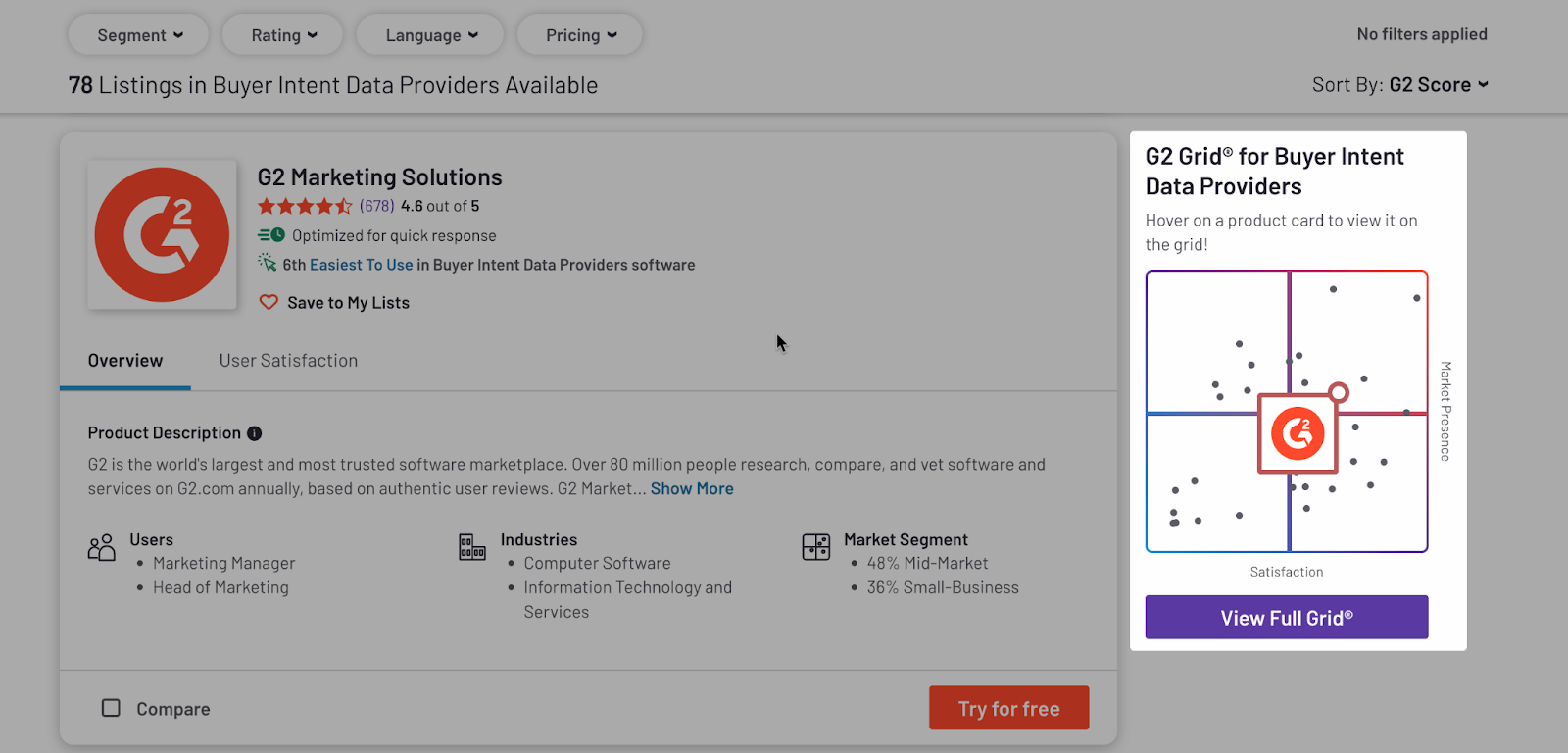
Para que una categoría de software o servicio sea elegible para un informe Grid®, debe tener al menos seis productos con 10+ reseñas, y más de 150 reseñas en total. Para calificar para inclusión, un producto o servicio debe tener al menos 10 reseñas en la categoría correspondiente.
Para ser elegible para un Grid® de suite de productos, una solución debe tener 10 o más reseñas en todas las categorías centrales definidas. La posición de una solución elegible se verá influenciada aún más por categorías suplementarias con más de reseñas. Para obtener más información, consulta la sección Suites de Productos.
Grids de Segmento®
G2 ofrece Grids® a nivel de segmento de mercado, que solo incluye reseñas de evaluadores que están empleados por una empresa dentro de un segmento de mercado particular. G2 utiliza las siguientes definiciones para los segmentos de mercado:
- Pequeña Empresa: 50 o menos empleados
- Mercado Medio: 51–1.000 empleados
- Gran Empresa: 1.001+ empleados
Grids Regionales®
G2 ofrece Grids® para cada región global, que solo incluye reseñas de evaluadores en la región correspondiente. G2 utiliza las siguientes regiones globales:
- África
- ANZ
- Asia
- Asia-Pacífico
- EMEA
- Europa
- Medio Oriente
- Medio Oriente y África
- Sudeste Asiático
Consulta el apéndice de informes para más información sobre las definiciones regionales.
Grid de Momentum®
G2 ofrece un Grid de Momentum® que destaca productos basados en el crecimiento. El modelo base de puntuación de Presencia en el Mercado para este Grid® se ajusta para favorecer productos con grandes cambios interanuales en el conteo de empleados, volumen de reseñas, seguidores en redes sociales y presencia en la web.
Se consideran tanto el cambio porcentual (relativo) como el cambio total (absoluto).
Los cambios interanuales se rastrean desde la primera aparición del producto en un Grid®, lo que significa que la primera vez que un producto puede aparecer en el Grid de Momentum® es un año después de su primer informe Grid®.
Informes de Índice
G2 publica una serie de informes de índice que resaltan el éxito de un producto en un área particular de negocios. Se utiliza un algoritmo único, pendiente de patente, para clasificar productos basados en las respuestas a grupos específicos de preguntas en el formulario de reseña de G2. Para ser elegible para un informe de índice, una categoría debe tener:
- 150+ reseñas en todos los productos de la categoría.
- Al menos seis productos con 10+ reseñas y al menos cinco respuestas a las preguntas específicas del informe descritas en la siguiente tabla.
| Informe de índice | Revisar preguntas del formulario (listadas en orden de importancia) |
|---|---|
| Usabilidad |
|
| Results |
|
| Implementation |
|
| Relationship |
|
Para calificar para inclusión, un producto o servicio debe tener al menos 10 reseñas.
G2 también ofrece cada informe de índice por segmento de mercado, que solo incluye reseñas de evaluadores empleados por una empresa dentro de un segmento de mercado particular. G2 utiliza las siguientes definiciones para segmentos de mercado:
- Pequeñas empresas: 50 o menos empleados
- Empresa mediana: 51–1.000 empleados
- Empresa grande: 1.001+ empleados
Mejor software
Cada año, G2 publica premios al Mejor Software para celebrar productos y proveedores de alto rendimiento en G2.
Para clasificar productos y proveedores en diferentes categorías, G2 utiliza puntajes normalizados de Satisfacción y Presencia en el Mercado. Para más información, consulte las secciones Puntuación G2 y Normalización.
Las puntuaciones se calculan primero dentro de las categorías para todos los productos con al menos una reseña en el último año. Los productos también deben aparecer en al menos una G2 Grid (teniendo al menos 10 reseñas en total) para una categoría infantil que se alinee con una lista de Mejor Software. Las puntuaciones se agregan luego y se comparan según los criterios de puntuación para cada una de las tres listas de Mejor Software: Mejores Empresas de Software, Mejores Productos de Software y Mejor Software por Función.
Solo se consideran para elegibilidad y clasificación las reseñas enviadas entre el 1 de enero y el 31 de diciembre del año calendario anterior.
Mejores Empresas de Software
Las 100 mejores empresas de software se clasifican en función de los puntajes de Satisfacción y Presencia en el Mercado ponderados. Específicamente, G2 puntúa la Satisfacción dentro de cada categoría y promedia esos puntajes en todos los productos de un proveedor. La Presencia en el Mercado se agrega y se puntúa en relación con todas las empresas de software elegibles.
G2 también publica listas geográficas de Mejores Empresas de Software, que destacan las principales empresas de la región o país correspondiente. La sede de una empresa, según LinkedIn, es la fuente principal utilizada para determinar la región de una empresa de software. Varios factores adicionales se utilizan según sea necesario, incluidos el lugar donde se fundó la empresa, dónde reside su equipo ejecutivo y dónde se encuentra la mayoría de su fuerza laboral.
Mejores Productos de Software
Los 100 mejores productos se clasifican en función de los puntajes de Satisfacción y Presencia en el Mercado ponderados. Específicamente, la puntuación de un producto se calcula primero para cada categoría, y luego esas puntuaciones de categorías se combinan para crear una puntuación general para el producto. La puntuación general se pondera luego en función de la competitividad de cada categoría.
La competitividad se determina por cuántos productos compiten en cada categoría y cuántas reseñas reciben esos productos.
G2 también publica los siguientes informes adicionales sobre Mejores Productos de Software:
- Satisfacción más alta: el ranking se basa únicamente en los puntajes de Satisfacción.
- Productos de más rápido crecimiento: el ranking se basa en los puntajes de Momentum.
- Segmento: Los rankings se basan en reseñas enviadas por evaluadores del segmento de mercado correspondiente.
- Novatos del Año: Este informe incluye los 25 principales productos que fueron listados en G2 y recibieron su primera reseña durante el año calendario anterior. Para calificar para inclusión, tanto el producto como su proveedor correspondiente deben estar recién listados.
Mejor Software por Función
Los 50 mejores productos se clasifican en función de los puntajes de Satisfacción y Presencia en el Mercado ponderados, basados en reseñas dentro de las correspondientes categorías principales de G2. La puntuación de un producto se calcula primero para la subcategoría, y luego esas puntuaciones de categorías se combinan para crear una puntuación general para el producto. La puntuación general se pondera luego en función de la competitividad de cada categoría.
Accediendo a sus informes y premios
Puede acceder a sus informes y premios basados en informes desde la pestaña Biblioteca de Informes en my.G2,
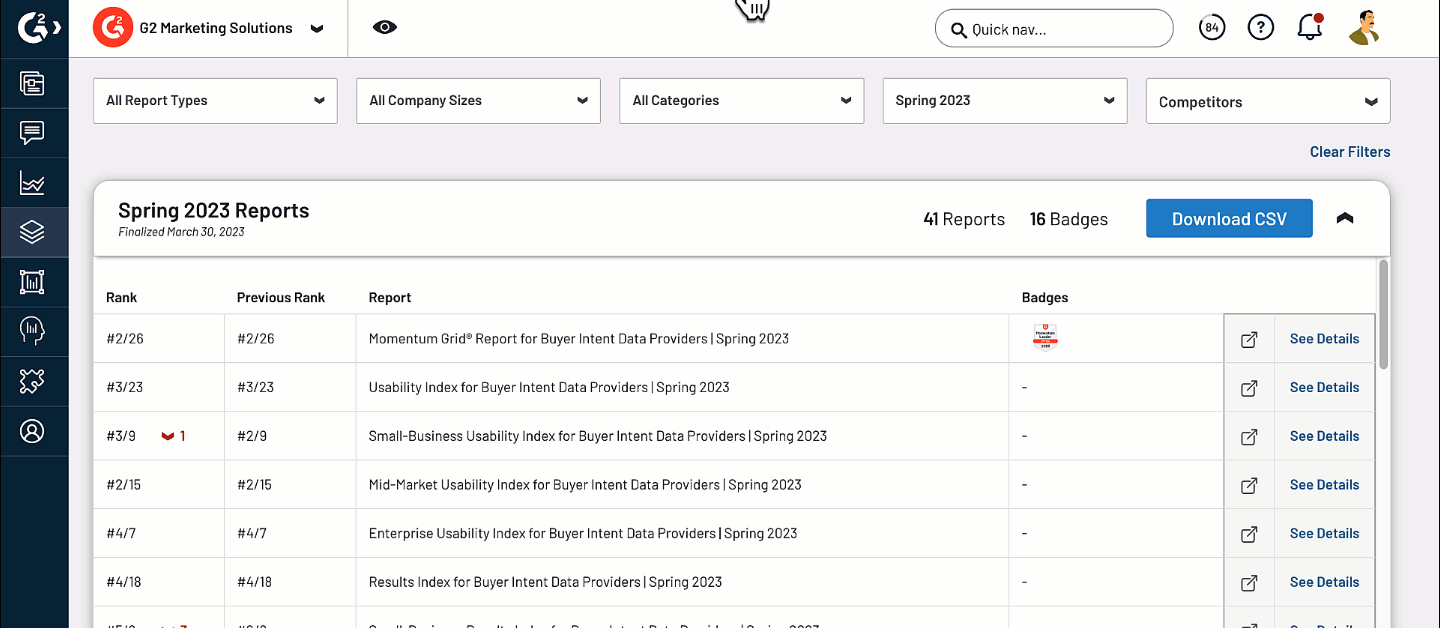
G2 muestra informes en borrador en esta pestaña aproximadamente dos semanas antes de cada publicación de informe.
Apéndice de informes
Calendario de informes
Consulte la Agenda de Investigación de G2 para acceder a las fechas clave para los próximos informes de G2, incluidos los plazos de envío de reseñas y fechas de publicación de informes.